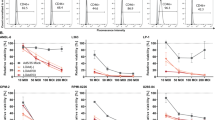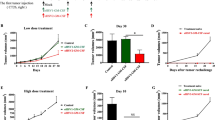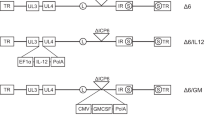Abstract
Multiple myeloma (MM) remains incurable despite the use of high-dose chemotherapy and stem cell transplantation. However, immunotherapy is expected to offer long-term disease control, or even possibly a cure. We have previously demonstrated the suppressive effect of a recombinant adenovirus carrying human wild-type p53, granulocyte–macrophage colony-stimulating factor, and B7-1 genes (Ad-p53/GM-CSF/B7-1) on the growth of laryngeal cancer cells. In the present study, we evaluated the effects of an Ad-p53/GM-CSF/B7-1-modified myeloma cell vaccine strategy aimed to induce apoptosis and to augment the immunogenicity of MM cells. Both MM cell lines and purified primary myeloma cells were infected with Ad-p53/GM-CSF/B7-1. High expression levels of these three genes were confirmed separately by Western blot, enzyme-linked immunosorbent assay (ELISA), and flow cytometry. When wild-type p53, GM-CSF and B7-1 genes were introduced, the growth of MM cells was inhibited via enhanced apoptosis and the immunogenicity of tumor cells was augmented. The combinatorial effect of these three genes on inducing cytotoxic T lymphocytes (CTLs) was more evident than that of p53 individually or any combinations of two (p53 plus GM-CSF or p53 plus B7-1). Furthermore, significant proliferation of autologous peripheral blood lymphocytes (PBLs) and specific cytotoxicity against autologous primary MM cells were induced in vitro. These results suggest that myeloma cell vaccination co-transferred with p53, GM-CSF and B7-1 genes may be a promising immunotherapeutic approach against MM.







Similar content being viewed by others
References
Gregory W, Richards M, Malpas J (1992) Combination chemotherapy versus melphalan and prednisone in the treatment of multiple myeloma: an overview of published trials. J Clin Oncol 10:336
Kyle RA (2000) The role of high-dose chemotherapy in the treatment of multiple myeloma: a controversy. Ann Oncol 11:55
Chiusolo P, Sica S, Piccirillo N, Giordano G, Laurenti L, La Barbera EO, De Stefano V, Serafini R, Leone G (2001) Molecular and clinical following-up after stem cell transplantation for multiple myeloma. Ann Hematol 80:90
Gahrton G, Björkstrand B (2000) Progress in haematopoietic stem cell transplantation for multiple myeloma. J Intern Med 248:185
Tarte K, Zhang XG, Legouffe E, Hertog C, Mehtali M, Rossi JF, Klein B (1999) Induced expression of B7-1 on myeloma cells following retroviral gene transfer results in tumor-specific recognition by cytotoxic T cells. J Immunol 163:514
Brown RD, Pope B, Gibson J, Murray A, Sze D, Hart D, Joshua D (2000) Dendritic cells from patients with myeloma are numerically normal but functionally defective due to TGFβ and IL-10 inhibition of the upregulation of CD80 expression after huCD40L stimulation. Blood 96:161a
Gorschluter M, Ziske C, Glasmacher A, Schmidt-Wolf IG (2001) Current clinical and laboratory strategies to augment the efficacy of immunotherapy in multiple myeloma. Clin Canc Res 7:2195
Hayashi T, Hideshima T, Akiyama M, Raje N, Richardson P, Chauhan D, Anderson KC (2003) Ex vivo induction of multiple myeloma-specific cytotoxic T lymphocytes. Blood 102:1435
Pan PY, Li Y, Li Q, Gu P, Martinet O, Thung S, Chen SH (2004) In situ recruitment of antigen-presenting cells by intratumoral GM-CSF gene delivery. Cancer Immunol Immunother 53:17
Mellman I, Steinman RM (2001) Dendritic cells: specialized and regulated antigen processing machines. Cell 106:255
Qiu ZH, Lao MF, Wu ZZ (2001) Construction of recombinant Adenovirus co-expressing human wild-type p53, GM-CSF and B7-1 genes (in Chinese). Chin J Biochem Mol Biol 17:329
Fiserova A, Hajek R, Holubova V, Buchler T, Sobotka J, Kovarova R, Musilova R, Bourkova L, Bulikova A, Mareschova I, Janackova Z, Vanova P, Kuglik P, Vorlicek J, Penka M (2002) Detection of 13q abnormalities in multiple myeloma using immunomagnetically selected plasma cells. Neoplasma 49:300
Boyum A (1964) Separation of white blood cells. Nature 204:793
Tu Y, Xu FH, Liu J, Vescio R, Berenson J, FAdy C, Lichtenstein A (1996) Upregulated expression of BCL-2 in multiple myeloma cells induced by exposure to doxorubicin, etoposide, and hydrogen peroxide. Blood 88:1805
Sun RX, Lu ZY, Wijdenes J, Brochier J, Hertog C, Rossi JF, Klein B (1997) Large scale and clinical grade purification of syndecan-1+ malignant plasma cells. J Immunol Methods 205:73
Bayer-Garner IB, Sanderson RD, Dhodapkar MV, Owens RB, Wilson CS (2001) Syndecan-1 (CD138) immunoreactivity in bone marrow biopsies of multiple myeloma: shed syndecan-1 accumulates in fibrotic regions. Mod Pathol 14:1052
Wang KS, Frank DA, Ritz J (2000) Interleukin-2 enhances the response of natural killer cells to interleukin-12 through up-regulation of the interleukin-12 receptor and STAT4. Blood 95:3183
Turner JG, Tan J, Crucian BE, Sullivan DM, Ballester OF, Dalton WS, Yang NS, Burkholder JK, Yu H (1998) Broadened clinical utility of gene gun-mediated, granulocyte-macrophage colony-stimulating factor cDNA-based tumor cell vaccines as demonstrated with a mouse myeloma model. Hum Gene Ther 91:1121
Li ZH, Wen XY, Mandelbaum S, Falcioni N, Hawley TS, Hawley RG, Stewart AK(2003) Improved therapeutic outcome following combination immunogene vaccination therapy in murine myeloma. Leuk Lymphoma 44:1775
Wendtner CM, Nolte A, Mangold E, Buhmann R, Maass G, Chiorini JA, Winnacker EL, Emmerich B, Kotin RM, Hallek M (1997) Gene transfer of the costimulatory molecules B7-1 and B7-2 into human multiple myeloma cells by recombinant adeno-associated virus enhances the cytolytic T cell response. Gene Ther 4:726
Dotti G, Savoldo B, Takahashi S, Goltsova T, Brown M, Rill D, Rooney C, Brenner M (2001) Adenovector-induced expression of human-CD40-ligand (hCD40L) by multiple myeloma cells. A model for immunotherapy. Exp Hematol 29:95
Dotti G, Savoldo B, Yotnda P, Rill D, Brenner MK (2002) Transgenic expression of CD40 ligand produces an in vivo antitumor immune response against both CD40(+) and CD40(−) plasmacytoma cells. Blood 100:200
Liu Q, Gazitt Y (2000) Adenovirus-mediated delivery of p53 results in substantial apoptosis to myeloma cells and is not cytotoxic to flow-sorted CD34+ hematopoetic progenitor cells and normal lymphocytes. Exp Hematol 28:1354
Ruffini PA, Biragyn A, Kwak LW (2002) Recent advances in multiple myeloma immunotherapy. Biomed Pharmacother 56:129
Trudel S, Li Z, Dodgson C, Nanji S, Wan Y, Voralia M, Hitt M, Gauldie J, Graham FL, Stewart AK (2001) Adenovector engineered interleukin-2 expressing autologous plasma cell vaccination after high-dose chemotherapy for multiple myeloma—a phase I study. Leukemia 15:846
Qiu ZH, Wu ZZ, Lao MF, Pan LZ, Li YM (2002) Growth suppression and immunogenicity enhancement of Hep-2 or primary laryngeal cancer cells by adenovirus-mediated co-transfer of human wild-type p53, granulocyte-macrophage colony-stimulating factor and B7-1 genes. Cancer Lett 182:147
Qiu ZH, Lao MF, Wang YF, Wu ZZ (1999) The expression of multi-genes via a recombinant Adenovirus and their effects of inducing apoptosis on lung cancer cells (in Chinese). Chin J Cancer Biother 6:83
Shi M, Wang FS, Liu MX, Zhang B, Lei ZY, Qiu ZH, Gao LX, Wu ZZ (2001) Enhanced chemosensitivity to anticancer agents in hepatocellular carcinoma cell lines transduced with recombinant adenoviral vector expressing wild-type human p53 genes in vitro (in Chinese). Chin J Cancer Biother 8:80
Acknowledgements
This work was supported in part by grants from the Major State Basic Research Development Program of China (973 Program) (No. 2004CB518801 and No. 2002CB713804), the National High Technology Research and Development Program of China (863 Program) (No. 2003AA216050) and the National Science Foundation of China (No.30400189).
Author information
Authors and Affiliations
Corresponding author
Rights and permissions
About this article
Cite this article
Ren, SP., Wu, CT., Huang, WR. et al. Adenoviral-mediated transfer of human wild-type p53, GM-CSF and B7-1 genes results in growth suppression and autologous anti-tumor cytotoxicity of multiple myeloma cells in vitro. Cancer Immunol Immunother 55, 375–385 (2006). https://doi.org/10.1007/s00262-005-0011-z
Received:
Accepted:
Published:
Issue Date:
DOI: https://doi.org/10.1007/s00262-005-0011-z




